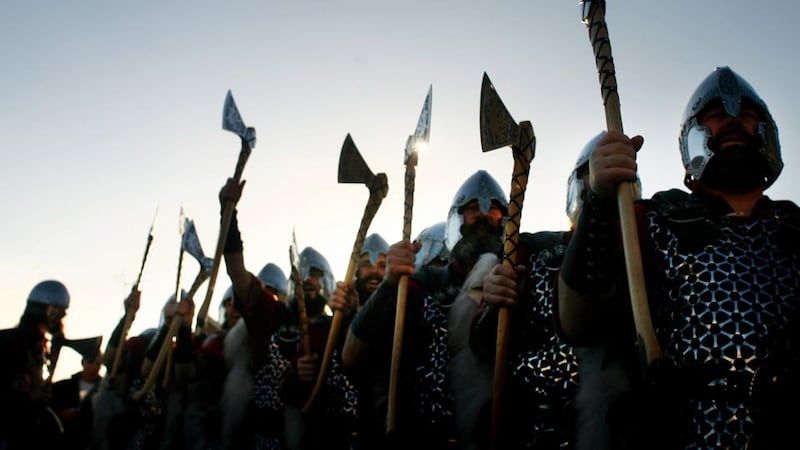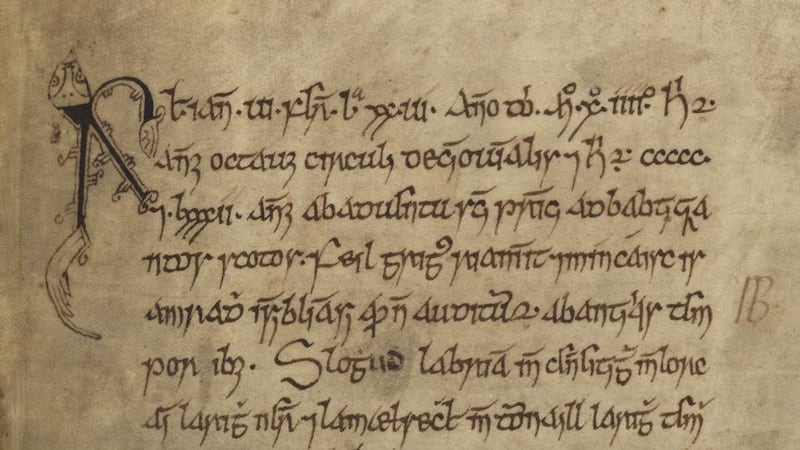Perhaps the day was shaping up to be a decent one. A nice summer’s morning, a settled sea. It was 795, the island of Rathlin, off the Antrim coast, where a monastery stands, and the monks were waking to another day in their penitent but peaceful lives. It would never have occurred to them that this would be ground zero. First contact. The beginning not just of a day but of an age.
Neither would it have been on the minds of the raiders as they approached along the coast, found a spot to drag their boat to shore, and moved stealthily towards the settlement.
The island awoke to violence.


And so it began. Not that we really know much about it. The Annals of Ulster tell us only this: “The burning of Rechru by the pagans, and Skye was plundered and robbed.”
Keep in mind that the Annals of Ulster were compiled in the 15th century, using earlier sources. Even the island of “Rechru” was often misdescribed as Lambay, off the north Co Dublin coast – although it was this part of the world that the Vikings returned to in 798, continuing their coastal raids, and plundering treasures and people, for the next 40 years or so, before they started to settle and extend roots that remain deep to this day.
They were called many things then. Heathens. Pagans. Gaill (foreigners). Finngaill if they were Norse; Dubhgaill if Danes. Nordmainn (Northmen), Ostmen (Eastmen). At first they were "Vikings" only to themselves, although the reason remains uncertain. It may have stemmed from a specific Norwegian bay, or a verb for going on an adventure.
Why did they first come on that adventure? Perhaps out of poverty, or triggered by better boatbuilding, or as a response to the increasingly aggressive Christianity establishing itself south of them. Uncertainty remains about this, too. Nevertheless, there had previously been a lengthy period of calm in Scandinavia before local raiding became a trend. Then they moved farther afield.
Whatever the reasons for their expansion towards Britain and Ireland and beyond, their summer expeditions turned into winter settlements, then into long-term communities.
Vikings camped in Dublin in 841, Cork in 848, Waterford before 860, Limerick before 887, Wexford before 892. They settled across the island, so that dozens of place names have Viking origins: Leixlip, Howth, Cork, Youghal, Fingal, Wicklow, Arklow, anywhere ending in “ford”, the Dubh Linn (Black Pool) of Dublin. Their impact can also be seen in the fact that their arrival led to four of the Republic of Ireland’s six cities.
They raided and traded, turning the island into an economic hub into which flowed many goods. But there was one commodity above all they excelled at: slaves.
They had taken "a great prey of women" from Howth in 821, and in time they became part of an extraordinary trading network that stretched north to Scandinavia and south to Africa. It meant that being grabbed by a Viking party could mean an unfortunate victim would eventually travel thousands of kilometres and through several hands.
And many were grabbed. By 950, it is conservatively estimated, 15 per cent of the population of western Europe were slaves. Limerick and Dublin wouldn't have become such strong economic hubs otherwise. By the 11th century those quintessential "pagans" had gradually converted to Christianity, meaning the slave trade had become unacceptable to some – and less profitable, anyway.
Because of it, Irish were scattered surprisingly far, sometimes concentrated in newly conquered areas. Iceland, where a few Irish monks are believed to have sought refuge before the Scandinavians got there, was settled by Vikings as the 10th century wore on. With them went Irish wives and slaves, so many that half of modern Icelandic women can claim Gaelic genetic heritage, compared with a quarter of the males.
Back in Ireland there were allegiances and intermarriages, and there remains discussion about whether the Vikings were interested not so much in conquering the land as in simply grabbing trading posts for their maritime empire.
Whatever the motivation, violence had gory consequences. In an age of rudimentary surgery, a barbed blade would have needed to be shoved through to the other side of the body. Stitches were courtesy of thick bone needles and linen.
Although all freemen were expected to own weapons, violent deaths wouldn’t have been as common as those from leprosy, smallpox, typhus and, in a time of basic sanitation, dysentery. For children, making it to the age of five was an achievement. For adults, getting into their 50s was a life well lived.
Meanwhile, markets grew around their settlements, servicing various needs. Trade in timber and food developed, and currency emerged, so that by the end of the 900s coins minted in Ireland were accepted in Viking Britain. The Irish word for penny, pinginn, came from the Old Norse penningr . Other words seeped into the language, too. Margadh (market), bróg (shoe), ancaire (anchor) and bád (boat) all owe themselves to the Vikings.
That is not the only language in which we see their legacy. It is there in our surnames, too. McDowell and Doyle are from Ó Dubhghaill, or Son of the Dark Foreigner. Higgins is from uigan , Norse for seaman. McAuliffe and McManus are thanks to Olaf and Magnus. McLoughlin and Howard are among other Viking surnames.
These were the consequences of a people who came to raid but who became an essential part of the culture, of its bloodline. Although violence continued along a complex array of allegiances and enmities, the Vikings had already affected Ireland in an extraordinary way through the Battle of Clontarf, and would continue to do so in the years to come.
And even when the true Viking age was over, the ripples continued to wash back to Ireland. After all, the "Norsemen" who travelled into Europe and settled in France would soon come back in another guise, with seismic consequences for the island of Ireland. But the Normans are for another supplement altogether.












